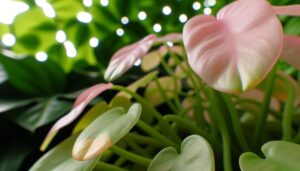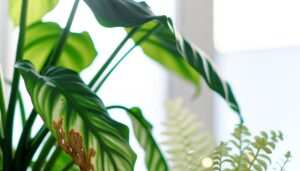What Is Philodendron Gloriosum 'Zebra'?
Philodendron Gloriosum 'Zebra' is an aroid belonging to the Araceae family, originating from Colombia's tropical rainforests. It is distinguished by its velvety, heart-shaped leaves, which feature prominent white veining and can reach lengths of up to 90 centimeters.
This terrestrial plant exhibits a creeping growth pattern, thriving in diffused light and consistent moisture. Optimal care involves maintaining a balance between soil hydration and drainage, utilizing a well-aerated mix of peat, perlite, and orchid bark.
Regular monitoring for pests like spider mites and aphids, alongside soil pH adjustments, ensures plant health. Continue to explore its care tips and unique characteristics.
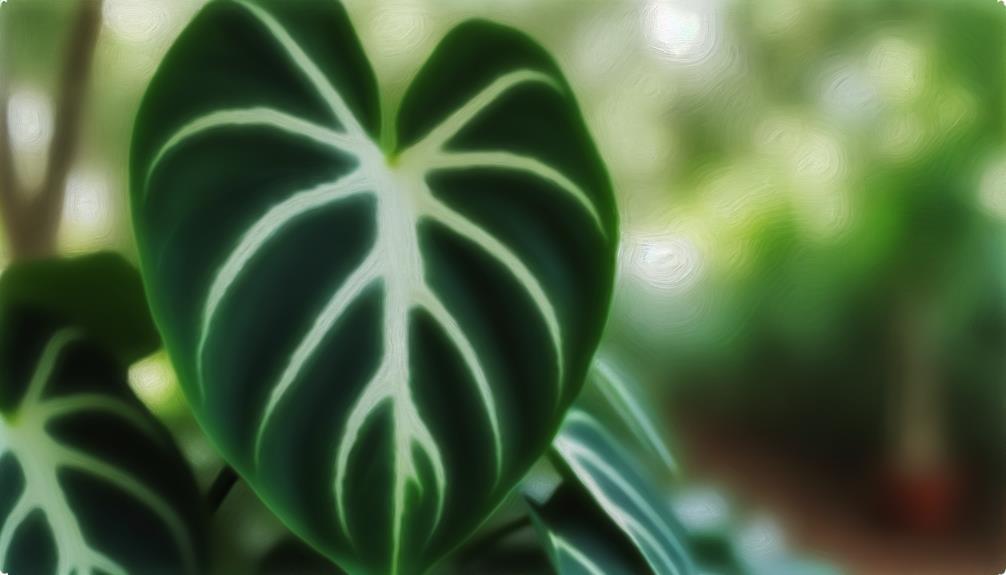
Key Takeaways
- Philodendron Gloriosum 'Zebra' is a tropical plant from Colombia with heart-shaped leaves.
- It features deep green leaves with prominent white veining and a velvety texture.
- The plant has a terrestrial, creeping growth habit and thrives in low-light conditions.
- Requires bright, indirect light and consistent moisture for optimal growth.
- Vigilant care is needed to prevent pests like spider mites and diseases like bacterial leaf spot.
Origins and History
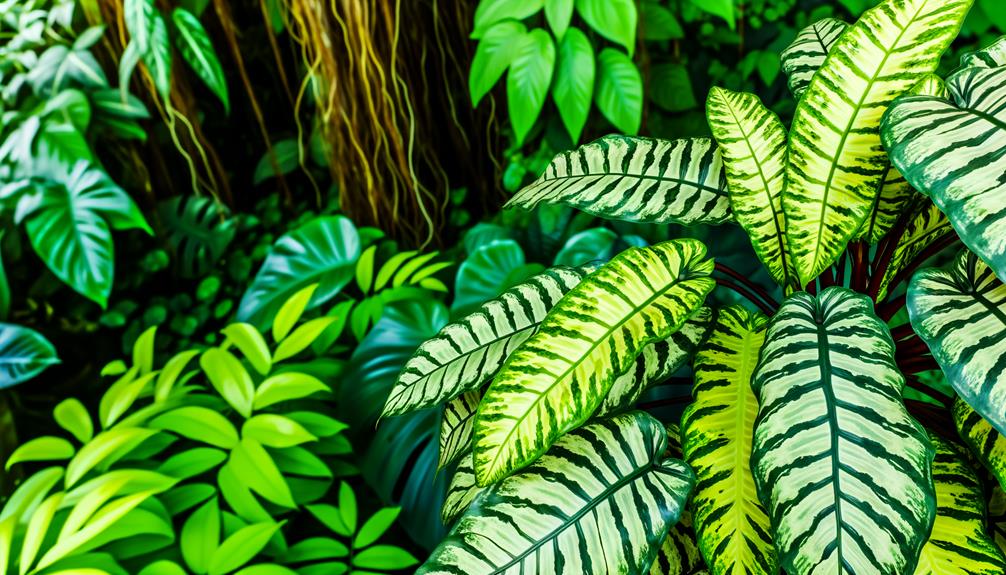
The Philodendron gloriosum 'Zebra', a striking cultivar of the Araceae family, traces its origins to the tropical rainforests of Colombia where it thrives in the understory of dense, humid environments.
This particular cultivar is a result of selective breeding aimed at enhancing specific phenotypic traits, primarily its distinctively veined foliage. Native to regions characterized by high humidity and consistent temperatures, P. gloriosum 'Zebra' has adapted to low-light conditions typical of forest floors.
Its ecological role includes contributing to the biodiversity of its habitat by providing shelter and support to various microfauna. The species was first described scientifically by Heinrich Wilhelm Schott in the 19th century, and since then, it has been a subject of horticultural interest due to its unique aesthetic appeal.
Physical Characteristics
Characterized by its large, heart-shaped leaves with prominent white veining, Philodendron gloriosum 'Zebra' exhibits a striking foliar morphology that distinguishes it from other members of its genus.
The leaves, which can reach up to 90 centimeters in length, are velvety to the touch, exhibiting a deep green hue contrasted by the distinct, almost skeletal, white venation. The petioles, typically elongated and robust, support the substantial leaf blade with a characteristic reddish tinge at their base.
The plant's growth pattern is terrestrial, sprawling horizontally along the ground rather than climbing. The thick, cordate leaves and their unique veining not only enhance its aesthetic appeal but also indicate its adaptation to low-light environments, typical of its native understory habitat.
Growth Habits

Philodendron gloriosum 'Zebra' exhibits a creeping growth habit, characterized by its impressive cordate leaves, which can attain substantial dimensions, often exceeding 30 centimeters in length.
This species thrives in environments with diffused light and consistent moisture levels, necessitating careful attention to its specific light-loving and moisture-loving requirements. Understanding these parameters is essential for optimizing its growth and maintaining the distinct variegation that defines this cultivar.
Leaf Size and Shape
Renowned for its large, heart-shaped leaves, Philodendron gloriosum 'Zebra' exhibits impressive foliar dimensions that can reach up to 90 centimeters in length and display distinct white veining patterns. These leaves, known botanically as aroids, possess a striking reticulated venation, which contrasts sharply against the deep green lamina.
The leaf blades, or laminae, are acuminate at the apex and cordate at the base, providing a broad surface area essential for photosynthesis. The petioles are robust and slightly grooved, supporting the expansive leaf structure. Additionally, the margins of the leaves are entire, contributing to their smooth, uninterrupted outline.
This species' foliage morphology greatly enhances its ornamental value, making it a prized specimen among horticultural enthusiasts and collectors.
Light and Water Needs
To flourish at its peak, Philodendron gloriosum 'Zebra' requires bright, indirect light and consistently moist but well-drained soil, guaranteeing its substantial leaves achieve full photosynthetic potential without risk of waterlogging. This species necessitates a carefully balanced watering regimen to avoid root rot while maintaining soil hydration. Optimum light conditions mimic its native understory habitat, promoting robust foliage and vivid variegation. The following table elucidates the ideal light and water parameters for this cultivar:
| Light Requirement | Watering Frequency | Soil Type |
|---|---|---|
| Bright, indirect light | Weekly, or when topsoil is dry | Well-draining, organic-rich |
| 10,000–20,000 lux | Consistent moisture | Aroid mix with perlite |
| Avoid direct sunlight | Avoid waterlogging | pH 5.5-6.5 |
Adhering to these conditions ensures the Philodendron gloriosum 'Zebra' achieves its aesthetic and physiological prime.
Light Requirements
Ensuring peak growth, Philodendron gloriosum 'Zebra' requires bright, indirect light to mimic its native understory habitat conditions. This species thrives under dappled sunlight, filtered through the canopy, which prevents direct solar exposure that can scorch its foliage.
Ideal placement involves situating the plant near east or north-facing windows, where it can receive diffused light for several hours daily. Artificial lighting can supplement natural light, with fluorescent or LED grow lights providing a spectrum similar to sunlight.
Light intensity should range between 10,000 and 20,000 lux (1,000 to 2,000 foot-candles). Prolonged periods of low light can impede photosynthesis, resulting in leggy growth and diminished leaf coloration, whereas excessive direct light can cause photodamage, characterized by leaf burn and chlorosis.
Watering Needs
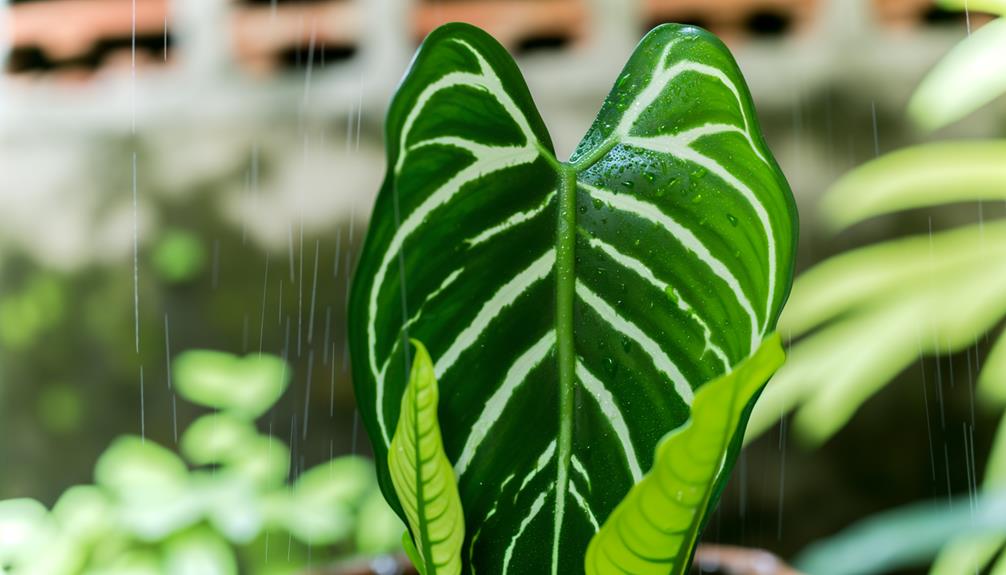
Philodendron Gloriosum 'Zebra' requires specific watering practices to maintain ideal moisture levels in the substrate, ensuring the health of its delicate root system. Watering frequency should be adjusted to prevent both waterlogging and desiccation, which can cause root rot and stress respectively.
Additionally, ensuring sufficient drainage through a well-aerated soil mix is crucial to avoid water accumulation and promote root oxygenation.
Optimal Moisture Levels
Maintaining the best moisture levels for Philodendron gloriosum 'Zebra' requires a balance between consistent soil hydration and adequate drainage to prevent root rot. This species thrives in a substrate with high organic matter content, such as a mix containing peat, perlite, and orchid bark, which retains moisture while allowing excess water to escape.
The soil should remain evenly moist but not waterlogged, mimicking the plant's natural tropical habitat. Overwatering can lead to Pythium and Phytophthora infections, detrimental pathogens that thrive in saturated conditions. Conversely, insufficient moisture can cause leaf desiccation and hinder root function.
Employing a well-aerated potting medium and ensuring proper container perforation are critical for maintaining the best soil moisture equilibrium and promoting healthy root development.
Watering Frequency Tips
To achieve ideal hydration for Philodendron gloriosum 'Zebra,' it is imperative to establish a watering schedule that reflects its native tropical environment, typically necessitating irrigation every 7-10 days depending on ambient humidity and temperature conditions. Monitoring soil moisture is critical; the top inch should be allowed to dry out between waterings. Employing a moisture meter can provide precise readings, ensuring best hydration without overwatering.
| Condition | Watering Frequency |
|---|---|
| High humidity (>60%) | Every 10 days |
| Moderate humidity | Every 7-9 days |
| Low humidity (<40%) | Every 7 days |
| High temperatures | Increase frequency |
Utilize tepid, filtered water to prevent root shock and mineral buildup, thereby promoting the health and vigor of Philodendron gloriosum 'Zebra'.
Drainage Importance
Proper drainage is essential for the Philodendron gloriosum 'Zebra,' as it prevents waterlogging and root rot, which can be harmful to the plant's health and growth. This species, native to tropical rainforests, thrives in well-aerated soil with excellent drainage capabilities.
Utilizing a substrate mix containing perlite, orchid bark, and peat moss ensures ideal moisture retention without water stagnation. Additionally, containers equipped with drainage holes facilitate the expulsion of excess water, safeguarding the root system from anaerobic conditions and pathogenic fungi.
Regular monitoring of the substrate's moisture level, coupled with a strategic watering regimen, is essential in maintaining the physiological balance of Philodendron gloriosum 'Zebra,' promoting robust growth and vibrant foliage.
Soil and Potting
Selecting the best soil composition for Philodendron Gloriosum 'Zebra' is crucial, as this species thrives in a well-draining, aerated medium rich in organic matter, such as a mix of peat, perlite, and orchid bark. Such substrates ensure prime root health and mimic the plant's natural habitat. The following table highlights key components and their benefits:
| Component | Benefit |
|---|---|
| Peat | Retains moisture and nutrients |
| Perlite | Enhances aeration and drainage |
| Orchid Bark | Provides structure and aeration |
The ideal pot should have ample drainage holes to prevent waterlogging, which can lead to root rot. Regularly check the soil pH, maintaining it between 5.5 and 6.5, as Philodendron Gloriosum 'Zebra' prefers slightly acidic conditions. Proper soil and potting practices are essential for sustained growth and health.
Common Pests and Diseases
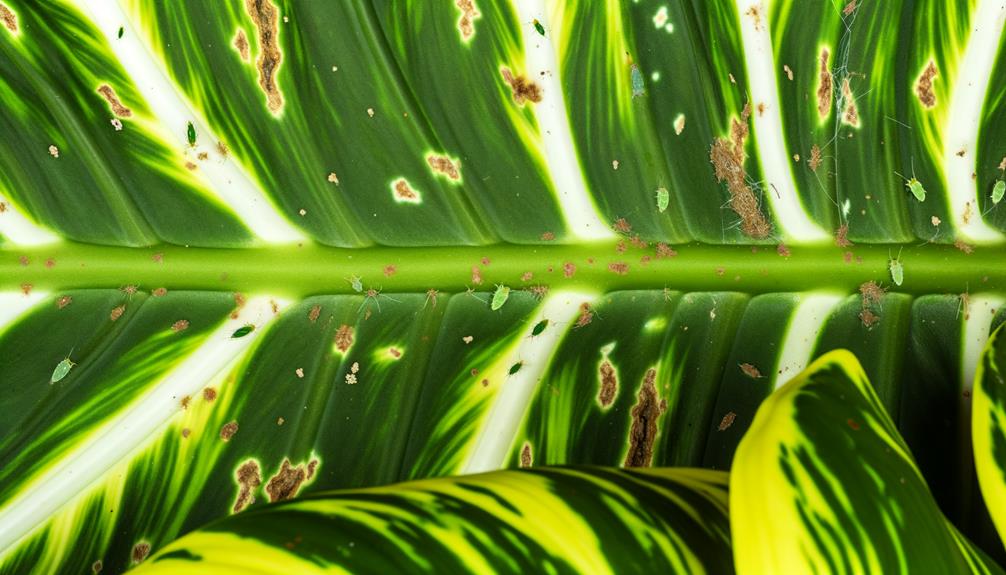
Maintaining the ideal soil and potting conditions is just one aspect of cultivating a healthy Philodendron Gloriosum 'Zebra'. It is also imperative to be vigilant about common pests such as spider mites (Tetranychus urticae) and aphids (Aphidoidea), as well as diseases like bacterial leaf spot caused by Xanthomonas campestris.
Spider mites, identifiable by their fine webbing and stippling damage, can be controlled via miticides or horticultural oils. Aphids, often found clustering on new growth, excrete honeydew which can lead to sooty mold. Infections by Xanthomonas campestris manifest as water-soaked lesions, necessitating immediate pruning of affected foliage and application of copper-based bactericides.
Regular monitoring and preventive care are essential for maintaining plant health.
Conclusion
Philodendron gloriosum 'Zebra' captivates with its unique variegation and striking foliage. This plant's origins trace back to the tropical regions of South America, showcasing large, heart-shaped leaves with distinct zebra-like stripes.
It thrives in well-draining soil, moderate humidity, and indirect light. However, one must remain vigilant against common pests and diseases. Will this botanical marvel flourish under the right conditions, or will it succumb to environmental challenges?
The answer lies in meticulous care and understanding of its specific requirements.

